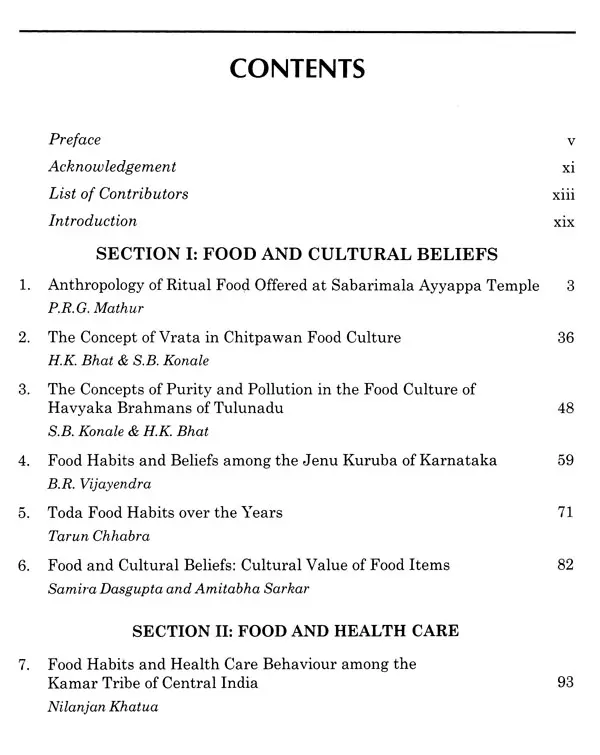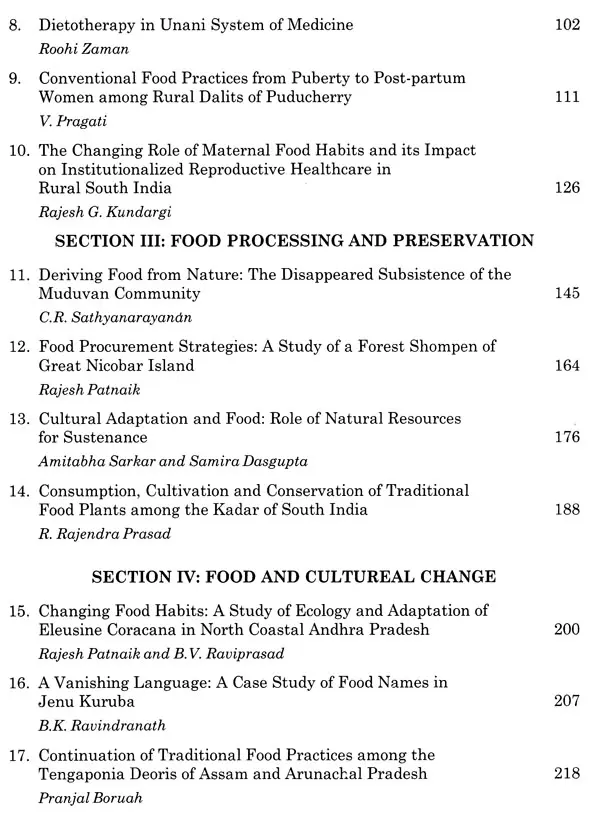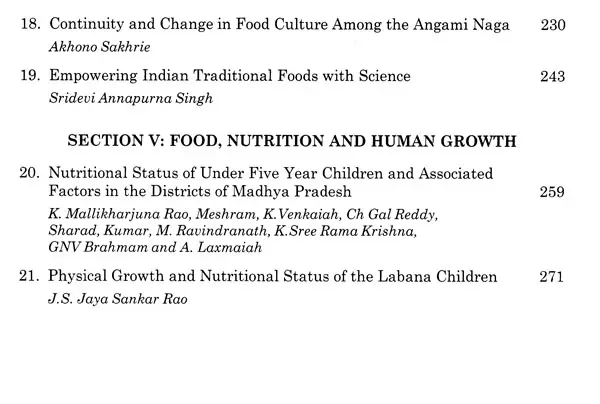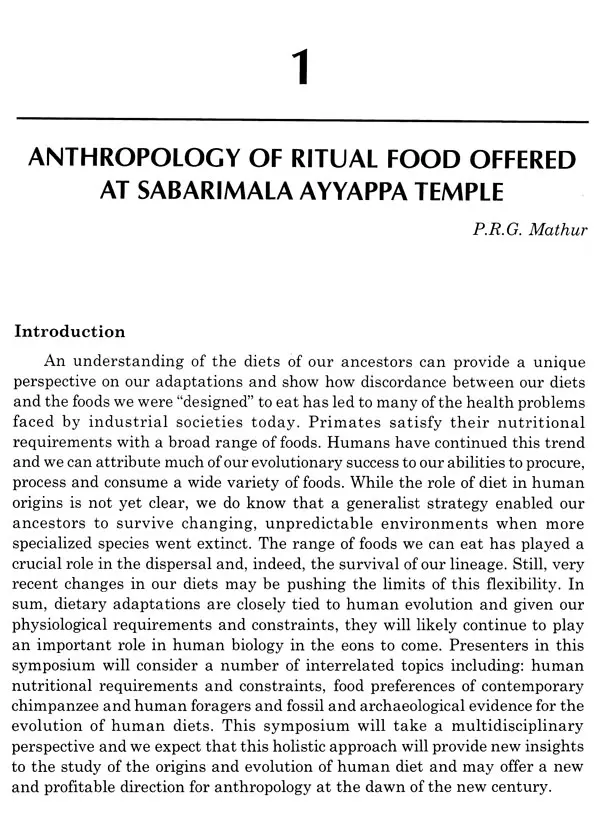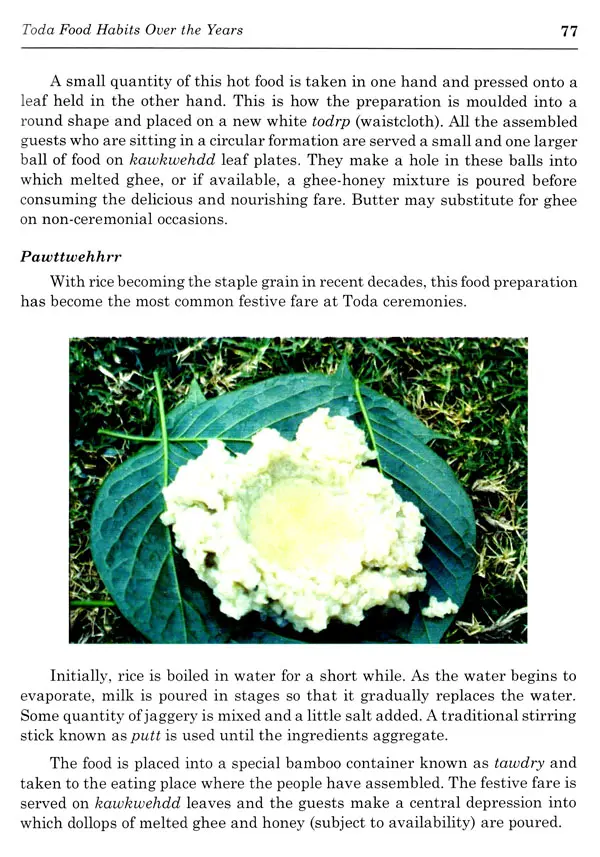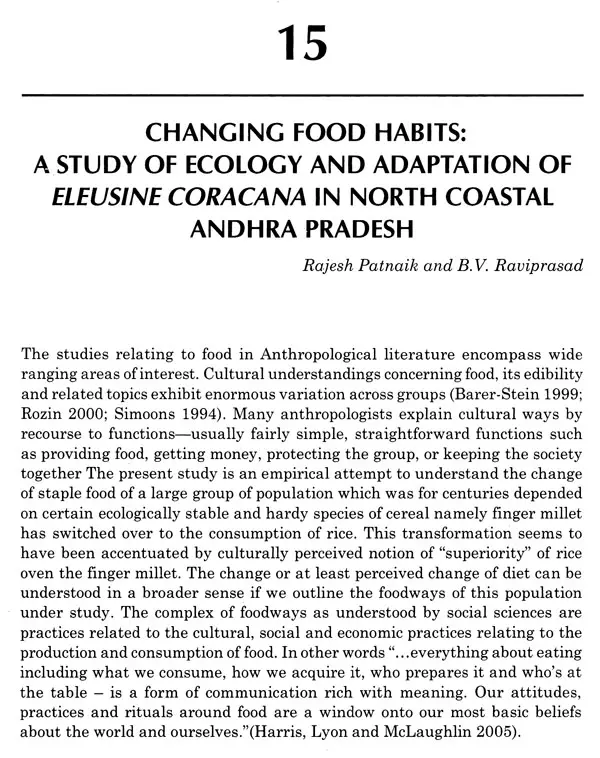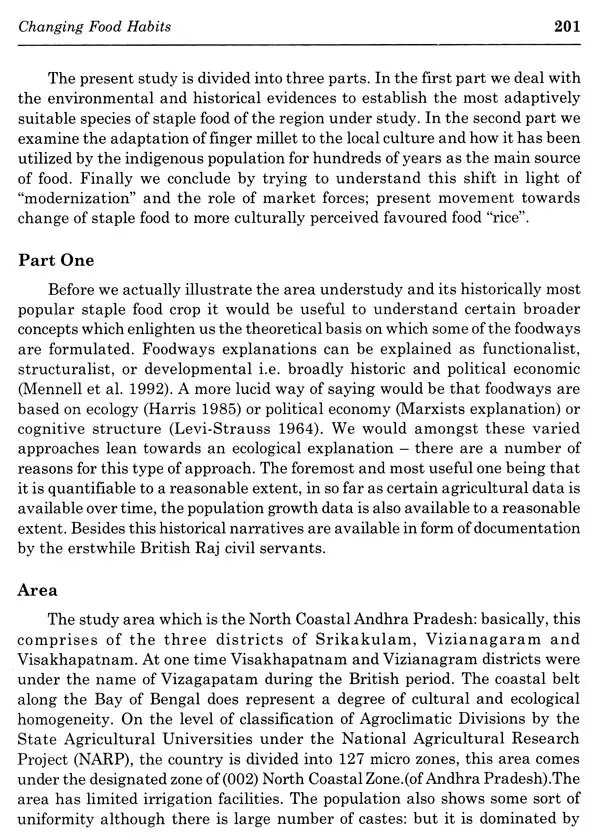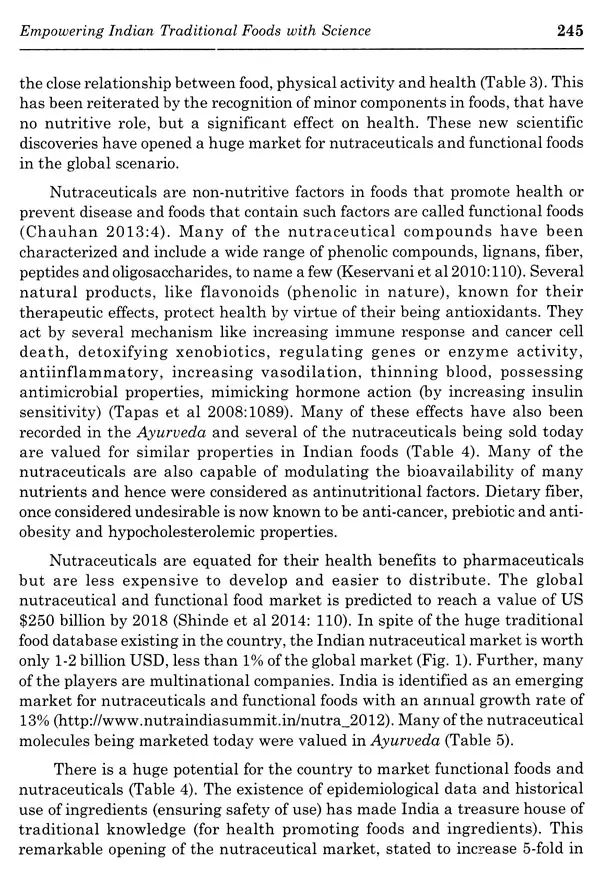
Anthropology of Traditional Indian Food
Book Specification
| Item Code: | UAP133 |
| Author: | B. R. Vijayendra & B. V. Raviprasad & Nilanjan Khatua |
| Publisher: | Aayu Publications, New Delhi |
| Language: | English |
| Edition: | 2017 |
| ISBN: | 9789385161407 |
| Pages: | 310 (Throughout Color Illustrations) |
| Cover: | HARDCOVER |
| Other Details | 9.50 X 7.50 inch |
| Weight | 700 gm |
Book Description
This book is the outcome of a National Seminar on Anthropology of Traditional Indian food organized by Anthropological Association (AA), Mysore, held on 12th-14 March 2013 Eminent scholars from all over India participated and presented papers in the seminar on themes such as food and health care. food and nutrition, food and cultural beliefs, food and language, food and human growth, food processing and preservation and food and cultural change. In the seminar forty three scholars presented papers out of which editorial board has selected 21 papers which are relevant to the theme of the seminar. This volume contains five sections; each section is made based on the themes and the articles are arranged in the respective sections for the benefit of the reader
B.R. Vijayendra holds Masters' and Ph.D, degree in Anthropology from University of Mysore and secured first rank in MA Anthropology. He has specialised in Socio Cultural anthropology and Medical Anthropology. He currently works in Anthropological Survey of India, Southern Regional Centre, Mysore as Assistant Anthropologist. He is one of the author and editor of the book 'Anthropology and Explorations in Indian Medical Anthropology At present, he is one of the Executive member of Anthropological Association, Mysore.
B.V. Raviprasad (b. 1960) is an Assistant Anthropologist of the Anthropological Survey of India, Andaman and Nicobar Regional Centre, Port Blair Dr. Prasad had completed 26 years of regular service in the Anthropological Survey of India, Ministry of Culture, Government of India. Anthropological Demography, Population Genetics and Applied Anthropology are his major areas of Interest. He worked among the Nicobarese tribe of A & N islands for his Doctor of Philosophy Degree. He was Post-doctoral Fellow in Eccles Institute of Human Genetics, University of Utah, USA Prior to joining the Survey, Dr. Prasad worked as Project Assistant in several research projects in the National Institute of Educational Planning and Administration (NIEPA), New Delhi and National Council of Educational Research and Training (NCERT), New Delhi and Department of Anthropology, Andhra University, Visakhapatnam. Dr. Prasad has published more than 50 research papers in National and International Journals and a book 'Urban Poor of Visakhapatnam City (2012) A few research papers on Nicobarese are extensively quoted others in their publications. He is life member in Indian Society of Human Genetics and Anthropological Association, Mysore and Secretary of the Anthropological Association, Mysore, presently.
Nilanjan Khatua is a well known in the field of Social-Cultural Anthropology and Museum Anthropology. His field of interest is tribal studies and tribal heritage. His academic achievements include M.Sc., M.Phil. and Ph.D. in Social Anthropology from Guru Ghasidas University, Bilaspur. He is currently associated with the Anthropological Survey of India as Assistant Keeper and Officer-in-Charge of Zonal Anthropological Museum, Mysore. Dr. Khatua has been recipient of young scientist award of MPCOST, Bhopal in Behavioural science in the year 1997. He is a life member of various academic bodies like Anthropological Association (AA), Society for Indian medical Anthropology (SIMA), Indian Anthropological Society (IAS), Museum Association of India (MAI), Indian Association for the Study of Conservation of Cultural Property (ASC), INCAA, and ICOM He had been to Chicago, USA in the year 2015 to undergo an advance training in the field of Museum studies under Vivekananda Memorial Programme for Museum Excellence - a Ministry of Culture approved programme. He has published more than forty research papers in national journals and edited books. He is also an author of a book entitled "Health, Ecology and Culture".
The Anthropological Association, Mysore, was established in March 1999 to promote activities related to anthropology. From a modest beginning it has progressed well during the last fifteen years.
The Association seeks to enhance the understanding of humankind and their global concerns without borders. The Association perceives anthropology holistically as the study of the material, cognitive, biological, linguistic and socio-cultural dimensions of humanity. It views the anthropological method of holism as a particular kind of epistemology.
The Association advocates anthropologically informed engagement in development work, while it also acknowledges the human agency or the capacity and capability of people distanced by miles and milieus to order their life ways. It is for critical debate to complement the intensive ethnographic and ethnological studies on which anthropology fundamentally depends, with particular concern for the voiceless people. In this context, the Association includes in its mission statement, to innovate and develop knowledge, tools and human resource to establish linkages between studies of human groups and emergent issues for future development programmes. The Anthropological Association intends to collaborate with other learned institutions of anthropology in India and abroad. In this direction, it became an institutional member of 'Indian National Confederation and Academy of Anthropologists (INCAA) so that it can initiate major collaborative ventures and enter into. partnership programmes with other educational institutions and research institutions, museums and industry.
The present volume consists of twenty three papers and brief introduction to the of this volume is presented below.
Prof. P.R.G. Mathur's paper opens a new paradigm regarding anthropology of ritual food in the Indian context. He categorically describes various ritual foods offered to Lord Ayyappa at the Sabarimala Ayyappa temple in Kerala state during daily worship and other festive occasions. His paper is considered as model paper so far ritual food is concerned. He describes rites and rituals performed in all the annual festival, conducted in Sabrimala Ayyappa temple. He specifies the various pooja (worship) along with the offerings (food and votive) in a tabular form at the end of his paper.
Dr. H.K. Bhat and Dr. S.B. Konale has discussed the sacred sphere of food culture and types of vrata (fasting and the types of food intake on various religious occasions) in Chitpawan Brahman Society, who are mainly concentrated in Udupi and Dakshin Kannada districts of Karnataka. The Chitpawan married women observe more than twenty uratas in their life time. The authors also specified how the concept of prescribed sacred food not only ensure certain nutritional balance but also help avoid junk foods as far as possible.
Dr. S.B. Konale and Dr. H.K. Bhat have tried to identify the concepts of purity and pollution in the food culture of the Havyakas and its practice in ordinary course of life as well as on special ritual occasions. Havyakas an endogamous community coming under Brahmana varna, and mainly concentrated in Shimoga, Uttara Kannad. Udupi and Dakshina Kannad districts of Karnataka and Kasaragod district of Kerala. One purifies and gets free from pollution only after drinks panchagavya -a mixture of five products of cow i.e. milk, curds, ghee, urine and dung. They have reported very elaborately the concept of madi (purity) and mailige (pollution) in discussing the food culture of Havyaka community.
Dr. B.R. Vijayendra in his paper discussed on food habits and other food ideology embedded in their culture among the Jenu Kuruba, one of the prefereable valnerable tribe of Karnataka. The food classification, the hot-cold dichotomy of foodstuffs and beliefs and taboos how plays an important role in their day to day life are explained in detail. The notions of human anatomy, categorisation of food, impact of beliefs and taboos on restriction and consumption of food are interesting issues discussed.
Dr. Tarun Chhabra's paper discusses the food habits of the Toda tribal community of Nilgiri Hills, Tamilnadu. Being a pastoral tribe they remain pure vegetarian. They subsist largely on dairy products along with millets, vegetables, roots and tubers. The neighbouring community Badaga gives a share of harvesting grains to the Toda. He concludes that much of the traditional food in the Toda services as "festive fare".
The idea of holding an inter-disciplinary seminar on food has been brewing in our minds for quite some time but on account of a variety of reasons we had to keep on postponing it. One of the main reasons for doing so was our search to locate scholars who had done sustained research on the subject from the vantage angle of their specialized disciplines. It is one of the paradoxes of life that. though food is integral part of human beings, for that matter of all living beings. there is not enough coordinated research on food. For example, enormous amount of research has been done on nutritional and bio-chemistry of food but how is all that related to the peoples perception of food has not received adequate attention from the scholars. In this respect Khare and Rao took a laudable initiative by bringing out a book entitled Food, Society and Culture (1986) which was an attempt to bring together trends in anthropological research on food and nutrition in South Asian Societies. Further, it will indeed of theoretical value to find out how notions about food are formed. Food is basic. Human beings right from the beginning have been experimenting and adapting what can be eaten or discarded, how it is to be processed and so on. Is it not amazing that majority of the grains consumed by modern human beings were discovered by early human beings. It is our considered opinion that there is tremendous scope for inter-disciplinary research on food.
The topic of food is fascinating and any discussion on it opens numerous windows in so many directions. Food is essential and its need is recurrent and perpetual. Nature has endured human beings to select their food from a wide range. This range becomes fabulously wider and larger because the human beings have developed the techniques of processing, cooking and flavoring them with add-on, which in a populist sense may mean that the human beings can eat anything they want. But that range, real or hypothetical gets greatly restricted because culture intervenes. The relationship between food and culture is complex and intertwined. Culture defines food Food on the other hand facilitates numerous cultural expressions in many ways. Apart from fulfilling the essential nutritional needs food is an important social symbol. It allows peep into the structure of the society. Food is ranked. It allows expressions of status, rules of reciprocity, intensification or break down of social relations. It allows expressions of joy or grief, pleasure or pain, friendly and hostile relations.
What is considered food differs from culture to culture and so also what constitutes a meal, major or minor? How food is processed, cooked, served and enten is defined by culture. What is discarded or preserved during the processing of food is bound by the belief and values of the people. One of the most crucial aspects of the journey of human kind on this planet has been search for food and ensuring its continuous supply which eventually led to domestication of animals and cultivation of plants which also gave rise to social practices such as sharing of food and developing the ideas of reciprocity. Every body could not hunt or gather and hence those who could not had to be provided which resulted in the system of social obligations and responsibilities. There must have been occasions or seasons when food was available in plenty which must have given rise to the idea of celebrations, as well as storage of food for later consumption. Storage of food not only helped people to overcome the problem when food was scarce but storage itself was a source of strength and status. Those who stored food must have been also vulnerable to attacks and therefore the need not only to store food properly but also insure its security. Storage of food is not a simple task. It is vulnerable to change in weather as well as it attracts all kinds of pests and therefore it required development of appropriate knowledge about the vulnerability of specific foods as well as development of technology to preserve it. For example, the Cholanaickan of Kerala, a food gathering and hunting community whose abode is in caves store their food in leaf bundles hung on the pegs of poles stuck in heaps of hot ash drawn from their hearths. This way they are able to save their precious food from ever aggressive crawling insects (Bhanu 1989:88). The Jarawa of Andaman and Nicobar Islands save the honey they collect in leaf bundles stung on creeper strings tied to two trees (Sarkar 1990).
In all societies festival foods are different from the food of the ordinary days. On occasion of festivals people are generally more liberal and relaxed. Food cycles of the ordinary days differ from the time of the day for example morning, mid-day and late in the evening meals. Among the Cholanaickan their major meal of the day begins late in the evening when food gathering and hunting parties return to their abode and continues till late in the night.
Book's Contents and Sample Pages

